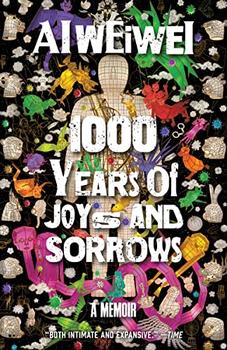Summary | Excerpt | Reviews | Beyond the Book | Read-Alikes | Genres & Themes | Author Bio

A Memoir
by Ai WeiweiThis article relates to 1000 Years of Joys and Sorrows
 Ai Weiwei is an influential creator, whose career has given rise to a great variety of works in many mediums. Accordingly, describing him merely as an artist does not do him justice, as he wears many hats, being a visual artist, architect, documentarian and writer. Ultimately, all of his work is underpinned with a strong thread of political activism, focusing primarily on the right of free expression in the Chinese cultural context.
Ai Weiwei is an influential creator, whose career has given rise to a great variety of works in many mediums. Accordingly, describing him merely as an artist does not do him justice, as he wears many hats, being a visual artist, architect, documentarian and writer. Ultimately, all of his work is underpinned with a strong thread of political activism, focusing primarily on the right of free expression in the Chinese cultural context.
Ai Weiwei started off as a conceptual modern artist, moving to the U.S. in 1981 and studying briefly at Parsons School of Design in New York City, where he was heavily influenced by Dadaism. He returned to China in 1993, where he continued developing his artistic style. Though some of his works were meant to inspire shock and outrage, such as a photograph of his raised middle finger in Tiananmen Square, he also gained mainstream approval, winning the competition to build the Bird's Nest stadium for the 2008 Beijing Olympics in collaboration with Swiss architecture firm Herzog & de Meuron.
The same year that Beijing sought to present a shiny exterior with the Olympics and the innovative Bird's Nest stadium, a major earthquake occurred in Sichuan. Over 5,000 young students perished in a school due to shoddy construction. Ai Weiwei began a "Citizens' Investigation" to shed light on the Chinese government's complicity in the large scale of this disaster, as well as the subsequent attempts to hide the truth and avoid accountability.
Ai Weiwei had started blogging in 2005, openly criticizing the government, and his blog was shut down in 2009. In spite of the Chinese government's heavy control and censorship of the internet, he pivoted to other internet platforms to continue his online social activism. He also arranged for a peaceful "sit-in" dinner party to protest the demolition of a studio that he had planned to unveil in 2010. Ultimately, he was prevented from attending the party because he was under house arrest.
Ai Weiwei was arrested in 2011 at the airport while he was en route from Beijing to Taipei for the opening of a solo exhibition at the Taipei Fine Arts Museum. Without receiving an explanation as to what he was charged with or the opportunity to notify his family, he was taken to an undisclosed location for 81 days, where he was constantly surveilled by guards and his every movement was dictated. This experience gave rise to Ai Weiwei's conviction to write his memoir, 1000 Years of Joys and Sorrows, in order to share the revelations he had during his detention, as well as create a legacy for his son to better understand and remember his father.
Because he has ties to the West and he champions free expression, there was an outpouring of support and protest to "Free Ai Weiwei," including a street art campaign in Hong Kong. As Chinese artists, activists and netizens have had to find creative ways to to elude censors, the "Free Ai Weiwei" campaign was also promoted with the phrase, "Love the Future," which is a homophone of Ai Weiwei's name, with "Ai" also meaning love and "Wei" meaning the future.
Ultimately, Ai Weiwei was charged with economic crimes, including tax evasion, and had his passport confiscated for four years. He has found many ways to give expression to the trauma and ordeal of this imprisonment, including a series of life-size dioramas entitled "S.A.C.R.E.D.", which debuted at the 2013 Venice Art Biennale. 1000 Years of Joys and Sorrows is yet another profound creative work about how China's restrictions on expression and movement have hindered Ai Weiwei's life, and his enduring commitment to freedom and human rights.
Ai Weiwei protest poster, courtesy of Art21
Filed under People, Eras & Events
![]() This "beyond the book article" relates to 1000 Years of Joys and Sorrows. It originally ran in January 2022 and has been updated for the
September 2022 paperback edition.
Go to magazine.
This "beyond the book article" relates to 1000 Years of Joys and Sorrows. It originally ran in January 2022 and has been updated for the
September 2022 paperback edition.
Go to magazine.
Your guide toexceptional books
BookBrowse seeks out and recommends the best in contemporary fiction and nonfiction—books that not only engage and entertain but also deepen our understanding of ourselves and the world around us.